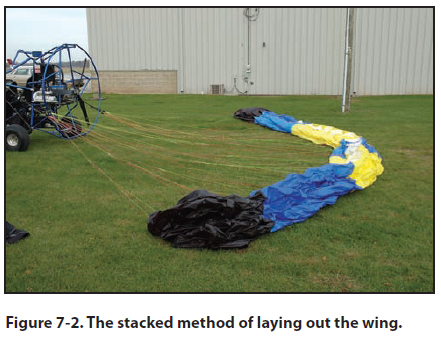|
Chapter 7 — Takeoffs and Departure Climbs
The Stacked (or Accordion) Method
The stacked method of laying out a wing involves
piling the wing up like an accordion with all of the
suspension lines stretched out as far as possible to the
rear of the cart. [Figure 7-2] The pilot can choose to
change from the inverted layout to the stacked method
on days where a slight wind is blowing or if the pilot
is concerned with the condition of the takeoff area.
Pavement or areas of the ground not covered in grass
in the takeoff runway will make it necessary to get
the wing off the ground with as little ground drag as
possible to avoid tearing or jeopardizing the integrity
of the wing fabric and/or lines.

With the wing spread out in the inverted configuration
and the lines inspected, you can pull the cart forward
to tighten all of the lines. This will begin the stacking
process. When the slack has been removed from all
lines, the pilot then goes back to the wing and finishes
the stacking process by hand. This usually means taking
the trailing edge of the wing and tucking it under
the rest of the wing.
To complete the process of stacking the wing there are
two options for laying out the leading edge. Generally,
if there is no wind you may want to leave the leading
edge open on top of the stack. If it is a little windy,
take the leading edge and tuck it behind and under the
rest of the wing. By “hiding” the leading edge over
and under the rest of the wing, the wind will blow
over the top of the stacked wing without catching the
open edges of the wing cells. When you start the takeoff
roll, the leading edge is pulled forward and up, is
exposed to airflow and begins a quick inflation.
Cockpit Management
The FAA regulations require the pilot to brief each person
on board on how to fasten and unfasten his or her
seatbelt and, if installed, shoulder harness. This passenger briefing should be accomplished before starting
the engine, to include information on the proper
use of safety equipment and exiting the aircraft. You
should also inform the passenger as to what to expect
during takeoff, flight, and landing, what feelings and
jolts are normal, what to do if the cart should roll over,
and what to do if the engine fails. Make sure passengers
are aware of the hazards and risks of a moving
propeller and educate them on the necessity of keeping
items secured so they don’t get sucked through the
propeller. Help them to secure their helmets (if worn)
and explain how to control the intercom. Show them
where to put their hands and feet and make sure any
cameras or equipment are secure. A passenger should
be aware that an aborted takeoff is always a possibility.
Tell them everything depends upon the wing—
if
the wing does not inflate properly, or does not inflate
and rotate in time to take off and clear an obstacle, the
engine will be shut down. Finally, emergency procedures
should be discussed. At a minimum, it should
be explained that in the case of a rollover, the passenger
should keep arms and legs inside the protected
areas of the cart. In case of an accident, the passenger
should not be holding onto a part of the structure
that could hit the ground or an obstacle and hurt their
hand or any other part of their body. The informed
passenger is a safe passenger and one that will enjoy
the flight.
After entering the cart, you should first ensure that
all necessary equipment, documents, checklists, and
navigation charts appropriate for the flight are on
board and secure. If a portable intercom, headsets, or
a hand-held global positioning system (GPS) is used,
the pilot is responsible for ensuring that the routing of
wires and cables does not interfere with the motion
or the operation of any control. Regardless of what
materials will be used, they should be neatly arranged
and organized in a manner that makes them readily
available. Loose items should be properly secured to
ensure nothing goes through the propeller or departs
the aircraft. All pilots should form the habit of good
housekeeping.
When you are comfortably seated, fasten the safety
belt and shoulder harness and adjust to a comfortably
snug fit. The shoulder harness must be worn at least
for the takeoff and landing, although because of the
open cockpit, it is highly recommended both pilot and
passenger wear seat belts at all times. If the seats are
adjustable, it is important to ensure the seat is locked
in position. Accidents have occurred as the result of
seat movement during acceleration or pitch attitude
changes during takeoffs or landings. When the seat suddenly moves too close or too far away from the
controls, you may be unable to maintain control of the
powered parachute.
|

